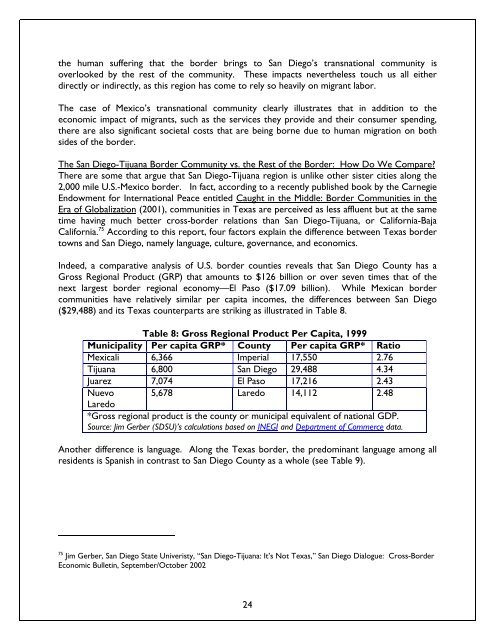Blurred Borders - International Community Foundation
Blurred Borders - International Community Foundation
Blurred Borders - International Community Foundation
You also want an ePaper? Increase the reach of your titles
YUMPU automatically turns print PDFs into web optimized ePapers that Google loves.
the human suffering that the border brings to San Diego’s transnational community is<br />
overlooked by the rest of the community. These impacts nevertheless touch us all either<br />
directly or indirectly, as this region has come to rely so heavily on migrant labor.<br />
The case of Mexico’s transnational community clearly illustrates that in addition to the<br />
economic impact of migrants, such as the services they provide and their consumer spending,<br />
there are also significant societal costs that are being borne due to human migration on both<br />
sides of the border.<br />
The San Diego-Tijuana Border <strong>Community</strong> vs. the Rest of the Border: How Do We Compare?<br />
There are some that argue that San Diego-Tijuana region is unlike other sister cities along the<br />
2,000 mile U.S.-Mexico border. In fact, according to a recently published book by the Carnegie<br />
Endowment for <strong>International</strong> Peace entitled Caught in the Middle: Border Communities in the<br />
Era of Globalization (2001), communities in Texas are perceived as less affluent but at the same<br />
time having much better cross-border relations than San Diego-Tijuana, or California-Baja<br />
California. 75 According to this report, four factors explain the difference between Texas border<br />
towns and San Diego, namely language, culture, governance, and economics.<br />
Indeed, a comparative analysis of U.S. border counties reveals that San Diego County has a<br />
Gross Regional Product (GRP) that amounts to $126 billion or over seven times that of the<br />
next largest border regional economy—El Paso ($17.09 billion). While Mexican border<br />
communities have relatively similar per capita incomes, the differences between San Diego<br />
($29,488) and its Texas counterparts are striking as illustrated in Table 8.<br />
Table 8: Gross Regional Product Per Capita, 1999<br />
Municipality Per capita GRP* County Per capita GRP* Ratio<br />
Mexicali 6,366 Imperial 17,550 2.76<br />
Tijuana 6,800 San Diego 29,488 4.34<br />
Juarez 7,074 El Paso 17,216 2.43<br />
Nuevo 5,678 Laredo 14,112 2.48<br />
Laredo<br />
*Gross regional product is the county or municipal equivalent of national GDP.<br />
Source: Jim Gerber (SDSU)’s calculations based on INEGI and Department of Commerce data.<br />
Another difference is language. Along the Texas border, the predominant language among all<br />
residents is Spanish in contrast to San Diego County as a whole (see Table 9).<br />
75 Jim Gerber, San Diego State Univeristy, “San Diego-Tijuana: It’s Not Texas,” San Diego Dialogue: Cross-Border<br />
Economic Bulletin, September/October 2002<br />
24















